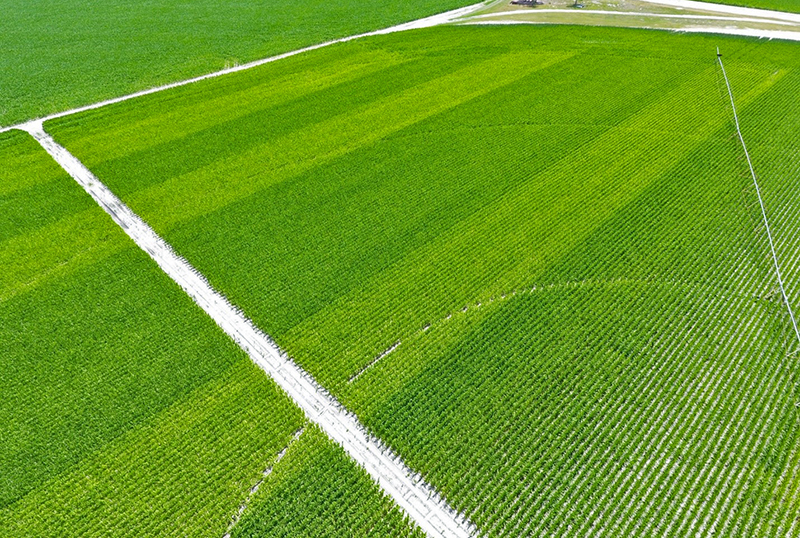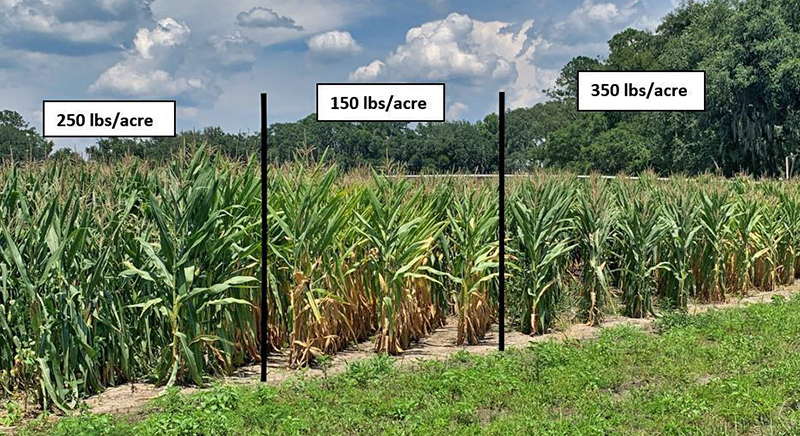
Figure 1) A replicated on-farm corn trial in Suwannee county testing various rates of controlled release fertilizer sources in spring 2020. Credit: De Broughton, UF/IFAS
De Broughton, Regional Specialized Agent, Row Crops, and Hailey Raulerson, Extension Assistant, UF/IFAS NFREC-Suwannee Valley
–
Why Controlled Release?
Corn is an important crop for Florida’s agriculture industry, with 95,000 acres of grain and silage corn planted in 2019 (USDA NASS 2019). Producers, extension agents, and researchers alike have been interested in reviewing corn nitrogen fertilization programs and methods to develop solutions to make more efficient plant uptake of fertilizer, to increase profitability, and to reduce impacts to water resources.
Projects involving a controlled release source of nitrogen have been studied over the past three years focused on corn, watermelon and carrots at the North Florida REC, Suwannee Valley in Live Oak, FL. The focus has been to help commercial producers evaluate different nutrient management strategies, increase the return-on-investment for fertilizer inputs, and ultimately lead to improved nutrient stewardship and decreased impact on water resources. Furthermore, researchers hope to gain a better understanding of the efficacy of implementing the 4R’s of Nutrient Stewardship (i.e., Right rate of fertilizer, Right placement of nutrients, Right source, and Right timing during plant development) simultaneously in corn production, as well as other vegetable and row crops. (Liu, 2019)
–
How does it work?
Controlled release fertilizers are typically applied once at the beginning of the crop season. Each fertilizer prill or granule is coated with a polymer-based material that protects the fertilizer and releases it over time. With this technology, the rate of release of the nutrients in the soil is dependent on temperature. The release rate also depends on the type and thickness of the coating. Release rate customizations by crop are manufactured based on projected growing season temperatures, crop growth cycle and crop needs. Most assume this type of technology is the same as a “slow release” fertilizer, but that is not the case with controlled release technology. Slow release fertilizers typically break down nutrients based on moisture, but with Florida’s unpredictable climate, that would not be a viable option.
In comparison, split applications of conventional fertilizers require trips across the field with higher labor and fuel costs. While controlled release fertilizers are more expensive to purchase, with fewer trips across the field, they have the potential to maintain or even reduce the overall cost. If reduced rates can be proven to consistently perform equal to conventional fertilizer programs, this technology may become more commonly adopted by farmers, which could ultimately result in reduced nitrogen leaching. (VSC News, Hochmuth, R. 2019)
–
Benefits of Controlled Release Fertilizer
- Reduced Environmental Impact: A major long-term benefit of utilizing controlled release fertilizer on crops is to the local environment. With this source, nutrients are released slowly and at the rate plants use them. The amount of nutrients lost through infiltration is thought to be much lower than through conventional water-soluble types of fertilizers. Nitrogen in the form of nitrate is very mobile in Florida’s sandy soils. With irrigation or heavy rainfall, the loss of nutrients is reduced in comparison to using water-soluble fertilizers, as the nutrient is bound within the coating of the fertilizer prill. Furthermore, less water would be withdrawn from the groundwater source. Pumping from irrigation wells might also decrease, as the conventional practice is to utilize liquid nitrogen applied through overhead pivot irrigation for corn.
– - Convenience of Use: Another proposed benefit of using controlled release is the peace of mind a producer receives in knowing the plants will receive the nutrients needed to grow a good crop, regardless of unexpected rainfall events. During times when corn has been rainfed continuously without the need for water, a grower using a water-soluble fertilizer must decide whether to fertilize plants and add excess water to the crop, or risk having a nutrient deficiency. Using the traditional soluble source depends on the irrigation system, and a water source to be delivered to the crop. A controlled release source will continuously release fertilizer without the need for irrigation, as increasing temperatures break down the polymer coating of each prill. This is designed to take place over a specific timeframe, customized to the growth needs of the specific crop it is applied to. There is potential for this fertilizer source is to be applied only once, unlike water-soluble fertilizers.
– - Reduced Application Costs: Labor, fuel and equipment wear-and-tear are always a concern for growers. The incorporation of a controlled release source can reduce labor costs by eliminating the need to mix and monitor water soluble fertilizers, and limits the need for expensive injection equipment or additional passes of broadcast spreaders through the field (for those who use dry soluble applications). This also eliminates the chance of improperly mixing a water-soluble fertilizer in the stock solution, which can cause excess nutrients to be applied unintentionally.
–
Controlled Release Fertilizer Trials
To verify these advantages, more research on the benefits of using controlled release fertilizer on crops is continuing to take place in Northeast Florida. In addition to more traditional research trials on location at the North Florida REC, Suwannee Valley in Live Oak, a region-wide effort is being planned for on-farm evaluations across the region for 2021. Interested corn and watermelon growers are now being sought for on-farm trials next season. Collaborators working with regional extension agents and producers on this large effort include: Harrell’s Fertilizer, Pursell Agri-Tech, Mayo Fertilizer, the Florida Department of Agriculture and Consumer Services, and the Suwannee River Water Management District.

Figure 2) A research trial conducted at the UF/IFAS NFREC, Suwannee Valley in Live Oak during the 2019 corn growing season. Nitrogen rates included 150, 250, and 350 lbs/acre of controlled release nitrogen fertilizer. Credit: De Broughton, UF/IFAS
–
References:
NASS, USDA. 2019 State Agriculture Overview
Hochmuth, R. 2019. New fertilizer technology may help farmers reduce nitrogen load. VSC News, vegetable and specialty crop news. October 21, 2019.
Liu, G., Morgan, K., Li, Y., Zotarelli, L., Wang, Q., DeValerio, J. 2019. What is 4R Nutrient Stewardship? UF/IFAS EDIS. Publication #HS1264.
Harrell’s Fertilizer
Pursell-Agri-Tech
- Farming More Efficiently with Grid Soil Testing and Precision Nutrient Application - November 12, 2021
- Calcium for Peanut Production in North Florida - May 28, 2021
- Evaluation of Controlled Release Fertilizers for Crop Production in Florida - December 11, 2020
